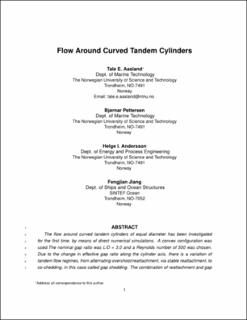Flow Around Curved Tandem Cylinders
| dc.contributor.author | Aasland, Tale Egeberg | |
| dc.contributor.author | Pettersen, Bjørnar | |
| dc.contributor.author | Andersson, Helge Ingolf | |
| dc.contributor.author | Jiang, Fengjian | |
| dc.date.accessioned | 2023-02-28T08:21:26Z | |
| dc.date.available | 2023-02-28T08:21:26Z | |
| dc.date.created | 2022-08-12T10:38:59Z | |
| dc.date.issued | 2022 | |
| dc.identifier.citation | Journal of Fluids Engineering - Trancactions of The ASME. 2022, 144 (12), . | en_US |
| dc.identifier.issn | 0098-2202 | |
| dc.identifier.uri | https://hdl.handle.net/11250/3054493 | |
| dc.description.abstract | The flow around curved tandem cylinders of equal diameter has been investigated for the first time, by means of direct numerical simulations. A convex configuration was used. The nominal gap ratio was L/D = 3.0 and a Reynolds number of 500 was chosen. Due to the change in effective gap ratio along the cylinder axis, there is a variation of tandem flow regimes, from alternating overshoot/reattachment, via stable reattachment, to co-shedding, in this case called gap shedding. The combination of reattachment and gap shedding gives near-zero drag and vertical forces for the downstream cylinder, whereas the corresponding forces on the upstream cylinder are comparable to single curved cylinders. Meanwhile, the opposite is true for the lift forces. A low-frequency variation of horizontal and vertical forces is seen, and this is attributed to a slow variation of the position where gap shedding commences. Finally, the concept of a critical angle is proposed to describe the transition to gap shedding, for a given combination of nominal gap ratio and Reynolds number. | en_US |
| dc.language.iso | eng | en_US |
| dc.publisher | ASME | en_US |
| dc.subject | Reynolds number | en_US |
| dc.subject | Wakes | en_US |
| dc.subject | Flow (Dynamics) | en_US |
| dc.subject | Cylinders | en_US |
| dc.title | Flow Around Curved Tandem Cylinders | en_US |
| dc.title.alternative | Flow Around Curved Tandem Cylinders | en_US |
| dc.type | Peer reviewed | en_US |
| dc.type | Journal article | en_US |
| dc.description.version | acceptedVersion | en_US |
| dc.rights.holder | Copyright: 2022 by ASME | en_US |
| dc.source.pagenumber | 8 | en_US |
| dc.source.volume | 144 | en_US |
| dc.source.journal | Journal of Fluids Engineering - Trancactions of The ASME | en_US |
| dc.source.issue | 12 | en_US |
| dc.identifier.doi | 10.1115/1.4054890 | |
| dc.identifier.cristin | 2042623 | |
| dc.source.articlenumber | 121301 | en_US |
| cristin.ispublished | true | |
| cristin.fulltext | postprint | |
| cristin.qualitycode | 1 |
Tilhørende fil(er)
Denne innførselen finnes i følgende samling(er)
-
Publikasjoner fra CRIStin - SINTEF Ocean [1345]
-
SINTEF Ocean [1417]
